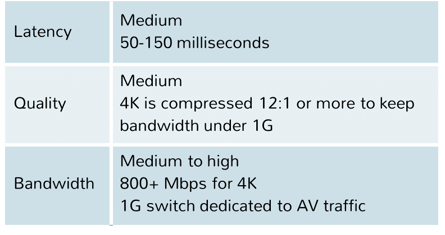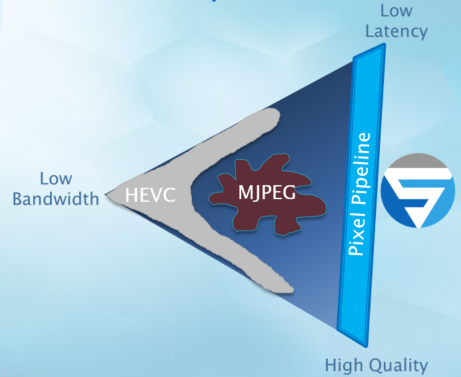In the first installment of this two-part blog series, I touched on the Codec Triangle and several factors that make up a complex relationship between bandwidth, latency and quality in Pro AV. Additionally, I discussed video image compression and the harmful effects it can have on your picture. SDVoE™-based Pro AV solutions, built on Semtech’s BlueRiver® technology, are transforming the matrix switch and allowing uncompressed, low latency AV content up to 4K60 over standard Ethernet infrastructure. SDVoE-based solutions are uniquely equipped to fight the harmful effects of compression by leveraging Ethernet. In this blog, I will break down common compression codecs used in the AV space today and offer insight into the pros and cons of each for your application.

Intraframe Codecs
The simplest form of compression is called “intraframe,” meaning “one frame at a time.” Quit
e simply, a single frame of video is compressed as a still image using a JPEG or JPEG 2000 compression algorithm and sent. Applying this on a sequence of images is known as MJPEG or MJPEG 2000 compression. The problem with this type of codec is that it does not optimize for anything in particular, and here is where it is easy to get into trouble with 1Gbs networking gear. To increase quality and decrease latency we need to turn down the compression and therefore consume more bandwidth. But still, even the very best in class, 1Gb AV over IP products that use this type of compression have visible defects in video quality and create a few frames of noticeable latency while consuming hundreds of megabits per stream. Even if [we][you?] could live with the quality and latency issues, those hundreds of megabits matter when it comes time to converge the AV and IT networks.


Interframe Codecs
When high compression is required, interframe codecs are useful. In this case, multiple frames are analyzed and compressed together. This works very well because subsequent frames of video are often very similar. The cost, however, is very high latency measured in hundreds of milliseconds. Both H.264 and HEVC are examples of interframe codecs. Both use extremely sophisticated mathematics to achieve extremely high compression rates with reasonable quality. The benefit is low enough bandwidth for video to pass over wireless links to mobile devices and the Internet. Although this latency and quality level is acceptable for some cases, other use cases demand better performance.


Pixel Pipeline Codecs
Finally, there is a new class of codecs called “pixel pipeline,” designed from the ground up to enable matrix switch performance on 10G Ethernet network - this is what SDVoE uses. Rather than waiting for an entire frame of video, the “pixel pipeline” waits only for few lines before encoding. With this codec, you give up compression efficiency, but latency is minimal and quality is outstanding because zero or very little compression is applied. With this type of codec, you only lose about 30% of the bits compared to 90-99% when using interframe or intraframe codecs. In practice, SDVoE compression can be considered to be mathematically lossless for most content.


Compromise Bandwidth, Not the Experience
When working with the three constraints that form the Codec Triangle – latency vs. quality vs. bandwidth, bandwidth stands apart from the other two. Video quality demands are only increasing, with 8K HDR displays looming on the horizon. Meanwhile human perception of latency remains the same. Latency is literally your time and greatly matters when directly interacting with a remote desktop or live camera. Of the three, only bandwidth is getting cheaper and becoming more plentiful.
HEVC is useful where bandwidth is limited. Wireless links and internet broadcasts demand ultra-low bandwidth and often high latency is tolerable: Streaming from YouTube? It is no problem to wait 5 seconds!
MJPEG and other similar 1G codecs do not make much sense. They do not optimize for anything in particular resulting in mediocre quality, noticeable latency and still consume most of the network bandwidth making it impossible to converge AV and IT onto the same network.
If dedicated video network is required, why not just use the matrix switch?
SDVoE on the other hand delivers the performance of the matrix switch on flexible IT infrastructure. In addition, because 1Gb bandwidth is always available for data traffic, it is possible to carry AV and IT on the same infrastructure.

So make sure you pick the right trade-off. Of the three constraints, only bandwidth is getting cheaper. Sacrifice bandwidth and not the experience!

Semtech®, the Semtech logo, and BlueRiver® are registered trademarks or service marks of Semtech Corporation or its affiliates. Other product or service names mentioned herein may be the trademarks of their respective owners.








